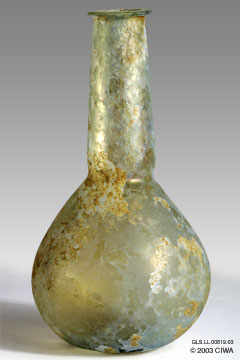Translucent glass bottle, Roman, 1-100 AD

Links to other views:⇒ Larger Viewif scripting is off, click the ⇒ instead. Links to others of type BottleGlass unguentarium, Syria, 100-300 ADIridescent blue bottle, Syria, 100-300 AD Iridescent bottle, Roman world, 1-200 AD Pyriform glass bottle, Roman, 100-400 AD Pyriform glass bottle, Roman, 80-150 AD Small glass phial, Egypt, c. 900 AD |
This large green glass translucent glass unguentarium has a pyriform (pear shaped) body extending into a thick, slightly tapered neck with a small mouth and narrow infolded rim. The bottom is flat with a faint pontil mark. The delicate, almost aerial quality of the glass shows through the silvery frosted light it reflects. Roman World, 1-100 AD. Parallels: “Perfume and cosmetic glass container unguentarium. Ht. 9.5 cm. Pale blue glass unguentarium with a rounded conical body extending into a tubular neck with a splayed and infolded rim. Roman World, 1st.-2nd. century AD” (Fortuna 1991:83 #153). Unguentarium “The earliest shape to be blown, the bulbous bottle with a tubular neck, was made throughout the Roman empire… This general purpose bottle, probably known as ampulla in antiquity, was made in a wide range of sizes. Small ampullae are called unguentaria or balsamaria in modern terminology after the contents which were often unguents or ointments, but the bottles were also used for scented oils, cosmetics, pigments, salves, medicines, and even dried herbs. The bulbous bottle was simply the simplest shape to blow because it needed very little tooling. The glassblower could make a spherical, piriform, or tubular bottle without touching the glass. The rim could be finished by reheating: the simple action of rotation caused the rim to flare outward and the edge to fold over” (Stern 2001:43). “A small receptacle for toilet preparations (e.g.: oil, scent, kohl). They were made of glass in numerous sizes (usually from 3 to 16 cm. high) and forms. Some examples made of core glass are in the form of various types of Greek vases (e.g. aryballlos, alabastron, lekythos, ampulla) and have combed decoration. Others of the Roman period were of coloured or colorless glass and were of spherical or conical shape, with a slender neck… Many such objects were deposited in Roman tombs, mistakenly thought to have been used to hold tears of the mourners, and were sometimes called ‘tear bottles’ or ‘lachrymatories’… also called a balsamarium.” (Newman 1977) Bibliography (for this item)Fortuna Fine Arts, Ltd.,1991 Shining Vessels: Ancient Glass from Greek, Roman, and Islamic Times. Fortuna Fine Arts, Ltd., New York, NY. (83 # 153) Bibliography (on Unguentarium)Newman, Harold1977 An Illustrated Dictionary of Glass. Thames and Hudson, London, UK. Stern, E. Marianne 2001 Roman, Byzantine, and Early Medieval Glass; 10 BCE-700 CE; Ernesto Wolf Collection. Hatje Cantz Publishers, Ostfildern-Ruit, Germany. |